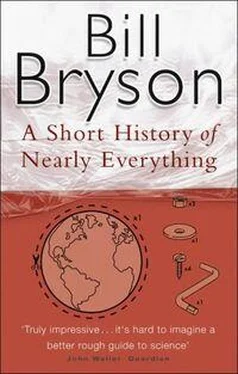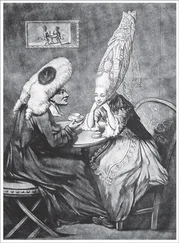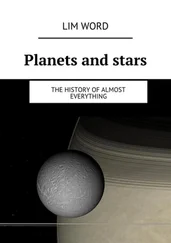Marie Curie spent the rest of her life working with distinction in the field, helping to found the celebrated Radium Institute of the University of Paris in 1914. Despite her two Nobel Prizes, she was never elected to the Academy of Sciences, in large part because after the death of Pierre she conducted an affair with a married physicist that was sufficiently indiscreet to scandalize even the French-or at least the old men who ran the academy, which is perhaps another matter.
For a long time it was assumed that anything so miraculously energetic as radioactivity must be beneficial. For years, manufacturers of toothpaste and laxatives put radioactive thorium in their products, and at least until the late 1920s the Glen Springs Hotel in the Finger Lakes region of New York (and doubtless others as well) featured with pride the therapeutic effects of its “Radioactive mineral springs.” Radioactivity wasn’t banned in consumer products until 1938. By this time it was much too late for Madame Curie, who died of leukemia in 1934. Radiation, in fact, is so pernicious and long lasting that even now her papers from the 1890s-even her cookbooks-are too dangerous to handle. Her lab books are kept in lead-lined boxes, and those who wish to see them must don protective clothing.
Thanks to the devoted and unwittingly high-risk work of the first atomic scientists, by the early years of the twentieth century it was becoming clear that Earth was unquestionably venerable, though another half century of science would have to be done before anyone could confidently say quite how venerable. Science, meanwhile, was about to get a new age of its own-the atomic one.
A physicist is the atoms' way of thinking about atoms.
Anonymous
AS THE NINETEENTH century drew to a close, scientists could reflect with satisfaction that they had pinned down most of the mysteries of the physical world: electricity, magnetism, gases, optics, acoustics, kinetics, and statistical mechanics, to name just a few, all had fallen into order before them. They had discovered the X ray, the cathode ray, the electron, and radioactivity, invented the ohm, the watt, the Kelvin, the joule, the amp, and the little erg.
If a thing could be oscillated, accelerated, perturbed, distilled, combined, weighed, or made gaseous they had done it, and in the process produced a body of universal laws so weighty and majestic that we still tend to write them out in capitals: the Electromagnetic Field Theory of Light, Richter’s Law of Reciprocal Proportions, Charles’s Law of Gases, the Law of Combining Volumes, the Zeroth Law, the Valence Concept, the Laws of Mass Actions, and others beyond counting. The whole world clanged and chuffed with the machinery and instruments that their ingenuity had produced. Many wise people believed that there was nothing much left for science to do.
In 1875, when a young German in Kiel named Max Planck was deciding whether to devote his life to mathematics or to physics, he was urged most heartily not to choose physics because the breakthroughs had all been made there. The coming century, he was assured, would be one of consolidation and refinement, not revolution. Planck didn’t listen. He studied theoretical physics and threw himself body and soul into work on entropy, a process at the heart of thermodynamics, which seemed to hold much promise for an ambitious young man. [15]In 1891 he produced his results and learned to his dismay that the important work on entropy had in fact been done already, in this instance by a retiring scholar at Yale University named J. Willard Gibbs.
Gibbs is perhaps the most brilliant person that most people have never heard of. Modest to the point of near invisibility, he passed virtually the whole of his life, apart from three years spent studying in Europe, within a three-block area bounded by his house and the Yale campus in New Haven, Connecticut. For his first ten years at Yale he didn’t even bother to draw a salary. (He had independent means.) From 1871, when he joined the university as a professor, to his death in 1903, his courses attracted an average of slightly over one student a semester. His written work was difficult to follow and employed a private form of notation that many found incomprehensible. But buried among his arcane formulations were insights of the loftiest brilliance.
In 1875-78, Gibbs produced a series of papers, collectively titled On the Equilibrium of Heterogeneous Substances , that dazzlingly elucidated the thermodynamic principles of, well, nearly everything-“gases, mixtures, surfaces, solids, phase changes . . . chemical reactions, electrochemical cells, sedimentation, and osmosis,” to quote William H. Cropper. In essence what Gibbs did was show that thermodynamics didn’t apply simply to heat and energy at the sort of large and noisy scale of the steam engine, but was also present and influential at the atomic level of chemical reactions. Gibbs’s Equilibrium has been called “the Principia of thermodynamics,” but for reasons that defy speculation Gibbs chose to publish these landmark observations in the Transactions of the Connecticut Academy of Arts and Sciences , a journal that managed to be obscure even in Connecticut, which is why Planck did not hear of him until too late.
Undaunted-well, perhaps mildly daunted-Planck turned to other matters. [16]We shall turn to these ourselves in a moment, but first we must make a slight (but relevant!) detour to Cleveland, Ohio, and an institution then known as the Case School of Applied Science. There, in the 1880s, a physicist of early middle years named Albert Michelson, assisted by his friend the chemist Edward Morley, embarked on a series of experiments that produced curious and disturbing results that would have great ramifications for much of what followed.
What Michelson and Morley did, without actually intending to, was undermine a longstanding belief in something called the luminiferous ether, a stable, invisible, weightless, frictionless, and unfortunately wholly imaginary medium that was thought to permeate the universe. Conceived by Descartes, embraced by Newton, and venerated by nearly everyone ever since, the ether held a position of absolute centrality in nineteenth-century physics as a way of explaining how light traveled across the emptiness of space. It was especially needed in the 1800s because light and electromagnetism were now seen as waves, which is to say types of vibrations. Vibrations must occur in something; hence the need for, and lasting devotion to, an ether. As late as 1909, the great British physicist J. J. Thomson was insisting: “The ether is not a fantastic creation of the speculative philosopher; it is as essential to us as the air we breathe”-this more than four years after it was pretty incontestably established that it didn’t exist. People, in short, were really attached to the ether.
If you needed to illustrate the idea of nineteenth-century America as a land of opportunity, you could hardly improve on the life of Albert Michelson. Born in 1852 on the German-Polish border to a family of poor Jewish merchants, he came to the United States with his family as an infant and grew up in a mining camp in California’s gold rush country, where his father ran a dry goods business. Too poor to pay for college, he traveled to Washington, D.C., and took to loitering by the front door of the White House so that he could fall in beside President Ulysses S. Grant when the President emerged for his daily constitutional. (It was clearly a more innocent age.) In the course of these walks, Michelson so ingratiated himself to the President that Grant agreed to secure for him a free place at the U.S. Naval Academy. It was there that Michelson learned his physics.
Читать дальше












